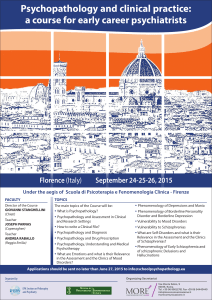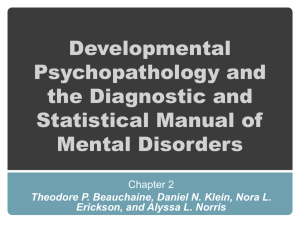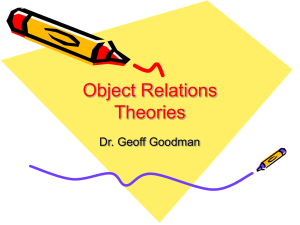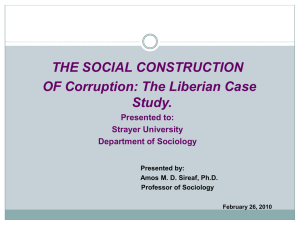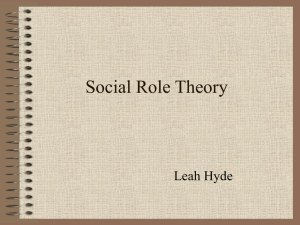Professor Mircea Lăzărescu MD Ph.D. Popescu Anca
advertisement
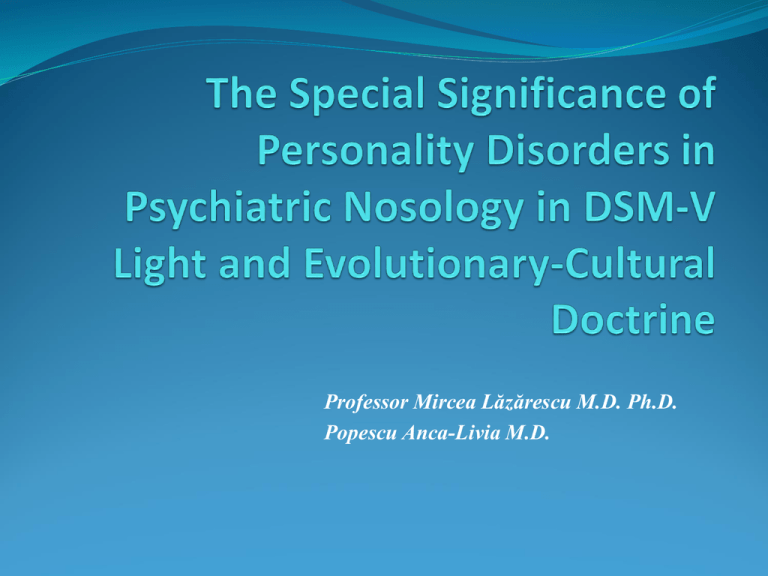
Professor Mircea Lăzărescu M.D. Ph.D. Popescu Anca-Livia M.D. The way in which personality disorders are circumscribed in DSM V suggests a similar revolution with the one made by DSM III which placed PD on a distinct axis. Current circumscription revolves around the phenomenological concept of self, which wasn’t even mentioned by DSM III. A scientific challenge falls into place because “self-identity”, “self-direction”, “empathy”, “intimacy” notions will have to be defined and operationalized. Synthetic characterizations from a textbook are useful but a phenomenological analysis of a vast and exemplary casuistry is required. In the same way abnormal features, like antagonistic ones (manipulation, deceit, hostility) and disinhibition (irresponsibility, impulsivity, risk), require definitions and operationalization, also through exemplary cases. This presentation intends to be an essay-style comment which, by briefly following the problem of PD history from the 20th century, underlines the framing of present option in anthropology’s vast evolutionary - historical paradigm, centered by the “meme” concept. The DSM-V’s step appears like an intellectual challenge for the anthropological development in general. Personality disorders (PD) have played and still play a special role in psychiatric nosology, posing doctrinal issues and forcing to maintain it connected to the general anthropology. If the psychopathology that was the basis of Kraepelin’s nosological – nosographical system was developed in the 19th century after the medical model of times (Berrios). The PD theme has imposed itself in the 20th century by appealing to the characteriology (Kretschmer). It also appealed to the idea of “the ideal case, the exemplary case”, idea that was brought in discussion by the methodology of the new “humanistic sciences”(Geistwischenschaft) (Jaspers, Schneider). Although a correlation with the clinical – syndromatic psychopathology was always taken into account, Schneider’s unsystematized typology, based on ideal cases, does not use the medical – psychiatric terminology. As is well known, Jaspers, after writhing “The General Psychopathology” (1913), has turned to philosophy, being the main existentialist philosopher of the 20th century. Schneider, although remaining a psychiatrist all his life (vouching professionally the last editions of “The General Psychopathology”) was in closed ideational relations with the phenomenological – personalism philosopher Max Scheller, from whom he took the concept of “person” for his book, entitled “Psychopath personalities”. The PD issue which he brought through his work didn’t accept, in his vision, the medical model, hiving instead a great importance to the spiritual dimension of human being. This beginning of the PD issue in psychiatry brought to surface a specific methodological – doctrinal tension, which is maintained nowadays. In the last years the psychopathology was intensely marked by the evolutionary doctrine which developed the idea that the mental functions were transformed and enriched during the anthropogenesis under the adaptability pressure and the creativity competition. The evolutionary doctrine, applied to human beings, implies the historical – cultural period too, and is sustained by the “meme” (Dawkins). This way so, it comes into debate the narrative language, which sustains the legends of the ancestors and the sacred mythology (which has as heroes the gods) as an essential component of the environment in which the human psyche differentiated. This presentation tries a brief overview of the PD conceptions in the last century, aiming to achieving the evolutionary – historical conception (cultural - spiritual), which is clearly reflected (although indirectly) in the new DSM – V PD conception. The differentiation from the medical model was maintained through the 20th century concept of “sociopathy” (Henderson) and especially through Cleckley’s concept of “psychopathy” (1941). Continuing this tradition, the psychopathy developed, until recently, as a parallel concept with the PD one, either as a separate cluster, or as a feature that can be distributed to all categorical types (Millon). The revolution that DSM III (1980) brought targeted the PD problem too, by bringing this diagnosis to an axis (Axis II) separated from the psychopathological syndromes axis (Axis I). But the essential change was the attempt of medicalization, by introducing the psychiatric expressions, the similar diagnosis techniques and the comorbidities research. In the 30 years that passed since the emergence of the DSM III, studies in the DP field increased exponentially. But the tensions between the medical model approach and the characterical – anthropological one did not disappear. DSM III system allowed the suggestion of corresponding and rapprochement between PD and syndromatic episodic pathology, correspondence that can be captured in a table. Type category Schizoid p.d. Schizotypal p.d. Paranoid p.d. Antisocial p.d. Histrionic p.d. Borderline p.d. Obsessive – compulsive p.d. Avoidant p.d. Dependent p.d. Syndromatic episodic pathology that corresponds Deficit schizophrenia Disorganized schizophrenia Paranoid schizophrenia Persistent paranoid delusion Addiction Conversion an dissociative disorder (corresponds to the traditional hysteria) Impulsive behavior Bipolar disorder (with rapid cycles) Obsessive – compulsive disorder Social anxiety disorder Depression disorder, anxiety disorder (Note: Narcissistic p. d., that is not included in ICD - 10, corresponds to some traditional characteristics of the Hysterical Megalomaniac p. d.). These suggestions of correspondence between PD and episodic disorders have validated themselves subsequently only partially by the comorbidity researches. The correlations between A, B and C clusters and these types of episodic disorders proved to be more significant. The reliance of the typology of PD on the defined clinical entities is not significantly evaluated. It also appeared the idea that the same psycho - cerebral functions stand both at the basis of episodic syndromes and that of PD but they manifest differently. The attempt of a too accentuated medicalization for PD, suggested by the DSM III philosophers, did not lead to significant results. This is because the development of the evolutionary doctrine reactivated Jaspers’ and others’ idea (Ey Tattosian) that the psychopathological states derive from normal, functioning structures that manifest dysfunctional in terms of a psychopathological minus. The difficulties that psychiatric medicalization of PD encountered favored the return to the appeal of characteriology. This fact imposed itself more so as the experts underlined that PD “symptomatology” is revealed “in the middle of everyday life” (Widiger); sometimes the evaluation of someone is important to be made in vacation periods (loisire) or through the behavior towards family members and neighbors (PAS-scale Tyrer). Contemporary characteriology offered two important instruments: Big Five Factors Model (Big Five) and interpersonal circumplex. Big Five derives from folk characterization language, from Alport’s and Cattel’s conceptual and practical efforts. Big Five Model, elaborated initially in English, was spread on the international level through NEO-PI-R instrument which was translated in many languages. Its utilization for PD circumscription, in the way in which it was categorial defined in DSM-III-IV, led to significant and promising results (Widdiger). But it stood out that the terms used for the characterization of the general population are not enough for PD characterization, so some investigation instruments that introduce specific terms were needed. (Livesley, Tyrer) In this regard diagnosis and characterization interviews proliferated, having several conceptual and terminological bases but sustaining the dimensional idea of the continuum from normality to abnormality of personality features. Efforts were made to synthesize obtained results with diverse dimensional instruments, in relation to correlated categories mainly with psychiatric nosology. A peack moment for these efforts was made by the teams coordinated by Krueger. The conclusion that four fundamental dimension are behind PD detached from multiplet dimensional studies. The interpersonal circumplex was the second underlined characteriological - dimensional system. Successive teams that began from interpersonal psychology theory worked on this system. In the same direction, Ieary, Kisker and Wiggins were mentioned. Beyond the varied interesting and useful results that these research projects brought, a link with psychobiology was made. This was very important in the upbringing of psychology and evolutionary psychiatry. It is worth to mention that relational circumplexes derive from Bakan’s circumplex model used in the upbringing of biopsychosociology by Wilson. Bakan’s Circumplex Dominant Hostile Friendly Submissive Wiggins’ 1991 epithets interpersonal circumplex PA confident, dominant Bc No arrogant, calculated 135° gregarious, extrovert 90° 45° De 180° Lm cold worm, agreeable 0° 225° 315° 270° Fg Jk modest, ingenuous closed, introvert Hi uncertain, submisive Bakan’s circumplex links functional psychology in biology and psychoanthropology. A feature such as attention and/or interpersonal domination plays a role not only in anthropoid monkey’s micro groups in which alpha male dominates and becomes the main fecundator. The same class characteristics are necessary in important functions in administration, police, and army. In human world personality features are aspired, shaped and cultivated by diverse statute requires and social roles. Histrionism is cultivated and considered a key performance in being an actor and in all social roles that require “capturing” the attention of others in order to influence (or even manipulate) them. An obsessive person’s devotion to work is cultivated by the practical productive work. Social isolation finds value in monastic institutions and contemplative professions. Suspicion, submission, avoiding failure strategy, they all have adaptive socio-human value, reason for which they are cultivated. The relation between personality features and socio-cultural functioning can be integrated in evolutionary – historical and cultural doctrine. A series of features developed because they were useful from an adaptability perspective. These are suspicion, deceit capacity, strategic submission, dominance and circumstantial manipulation of others. These features are cultivated because they are useful for different social roles. But the unusual, deficitary distorted function of these useful features would bring us to the abnormality of personality disorders. This sort of interpretation underlines peoples’ public manifestations in a socio-cultural space, especially at the level of statutes, social roles and interpersonal situations. This interpretation, that has been evoked for a long time now, would explain the “masking” of some excessive personality features and some excessive behavioral models by socio-cultural parameters. Those with obsessive tendencies are partially compensated in an environment where the accent is put on the administration, a growing number of monasteries (and the internet) would help to compensate many schizoid people and commando troupes assimilate people with antisocial features. But this interpretation does not clarify in a positive way the characterization area of PD. The particular aspect of the solution given by DSM-V, keeping in mind the evolutionary – historical doctrine, is that it integrates positively the phenomenological tradition of psychopathology that was reactivated in the same time with the cognitivism. One of the cognitivism’s trades, based on the contribution of “mind philosophy”, is the difference between “subjective perspective of the first person” and “objective perspective of the third person”. 100 years ago, Jaspers instated through his book, “The General Psychopathology”, the underlined tradition that in psychiatric semiology most symptoms are subjective experiences. Self-doctrine, that developed in the last two decades, that is based on cognitivist and phenomenological studies, makes the difference between: Self-agency, meaning the one with the present experiences, situated in a problematic situation. Self-identity, biographical narrative self, the one that sustains the continuity of a person’s feelings and it permits anchoring in long lasting projects. These aspects are found in the insistent comments regarding the disorders of self in the PD case, which were made in the last two decades by Livesley and Clonninger. The approach of PD in DSM-V succeeds to combine: Clinical observation concerning that the PD semiology is found in the day to day life especially in the intimate life area (family, loisire) and not necessary in the exercising of social roles (Widdiger - Tyrer). Cognitivism phenomenological synthesis on the differences between present self-agency and biographical identity – self. Also, the accent is on the disturbance of intimate and empathy relations. The mentioning of intimacy and empathy places the accent, even more, on the PD’s problem in life’s intimacy area, at a different pole from public life, that of statutes and social roles. Although, at first sight, it would seem paradoxical, this approach signs up in the evolutionist, historical and cultural paradigm also. Human psyche has gotten its own outline out of over 1.000.000 years of anthropogenesis, especially after the development of articulated language and the “social brain”, events that happened over 150.000 years ago. But the specificity itself has been developing in the last 10.000 years of culture when the human being has been living a sedentary live, working the land and calling upon the gods. In this period, the structural differentiation of human institutionalized practices and the polarization between intimate life and public one. Public life consists in exercising some statutes and social roles in the open space of community. Intimate life is built around family and friends, based on the subjective nature of ones’ conscience. Although the present differentiation of conscience’s subjectivity is a more recent process, of the last 2.000 years, it has an evolutionary historical and fundamental gain for human kind. The empathy and “intimacy of dual experiences” take place in this space. The feeling of self-identity and self-definition through projections of self-transcendence are found in this space too. The fixation of the PD problem by DSM-V at subjectivity of intimate and dual life level is an act of great courage and great perspectives. In fact this perspective is a great challenge. Present psychopathology is used with evaluation scales in which the accent is on the observational aspect. In the near future, theoretical and practical instruments need to be elaborated for a more rigorous evidence of normality and abnormality, of the subject’s identity, of his future projections (self-transcendence) on intimacy and empathy relations. Although all these ideas benefit from a traditional recognition at the common sense level, the psychopathology of the near future will have to open the phenomenological – existential files that seemed closed. Thank you!
